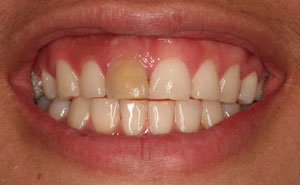

WHAT ARE THE CAUSES OF DISCOLOURED TEETH?
Your teeth can become discolored by stains on the surface or by changes in the tooth material. There are three main types of tooth discoloration:
Extrinsic discoloration — This occurs when the outer layer of the tooth (the enamel) is stained. Coffee, wine, cola or other drinks or foods can stain teeth. Smoking also causes extrinsic stains.
Intrinsic discoloration — This is when the inner structure of the tooth (the dentin) darkens or gets a yellow tint.

YOU CAN GET THIS TYPE OF DISCOLORATION IF:
- You had too much exposure to fluoride during early childhood.
- Your mother used tetracycline antibiotics during the second half of pregnancy.
- You used tetracycline antibiotics when you were 8 years old or younger.
- You had trauma that affected a tooth when you were a young child. A fall, for example, may damage the developing permanent tooth.
- You had trauma in a permanent tooth, and internal bleeding discolored the tooth.
- You were born with a rare condition called dentinogenesis imperfecta. This causes gray, amber or purple discolorations.
Age-related discoloration — This is a combination of extrinsic and intrinsic factors. Dentin naturally yellows over time. The enamel that covers the teeth gets thinner with age, which allows the dentin to show through. Foods and smoking also can stain teeth as people get older. Finally, chips or other injuries can discolor a tooth, especially when the pulp has been damaged.
HOW CAN I TREAT DISCOLOURED TEETH?
Many extrinsic stains caused by food and drink can be removed by regular professional cleanings and home care. Good home care includes brushing, flossing and rinsing after meals.
ZOOM BLEACHING: The Zoom Teeth Whitening System, sometimes called Zoom laser teeth whitening, is a powerful in-office whitening system . The process uses a 32% Hydrogen Peroxide light activated gel to achieve rapid and powerful whitening results with just a single procedure. Bleaching will not lighten some stains, such as tetracycline stains. In this case, your dentist may recommend covering the discolored areas. This also may be useful when the tooth is chipped or badly damaged. A tooth can be covered with a color-matched composite bonding material. Another option is to get veneers. These are thin ceramic shells that cover the outer surfaces of the teeth.